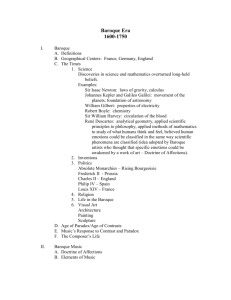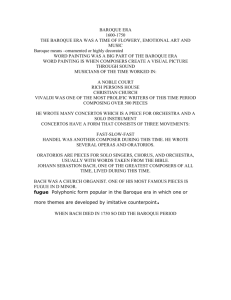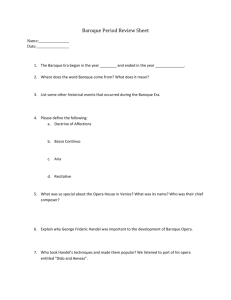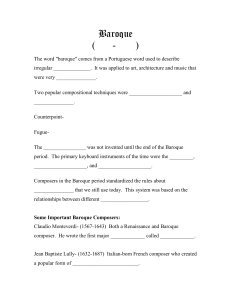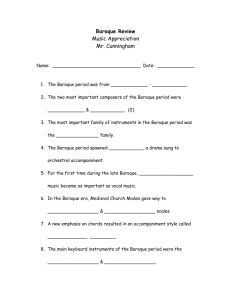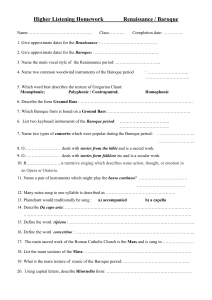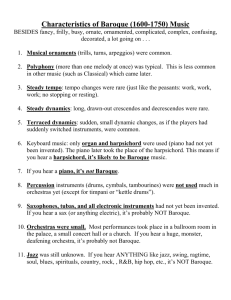Baroque Quiz-Key
advertisement
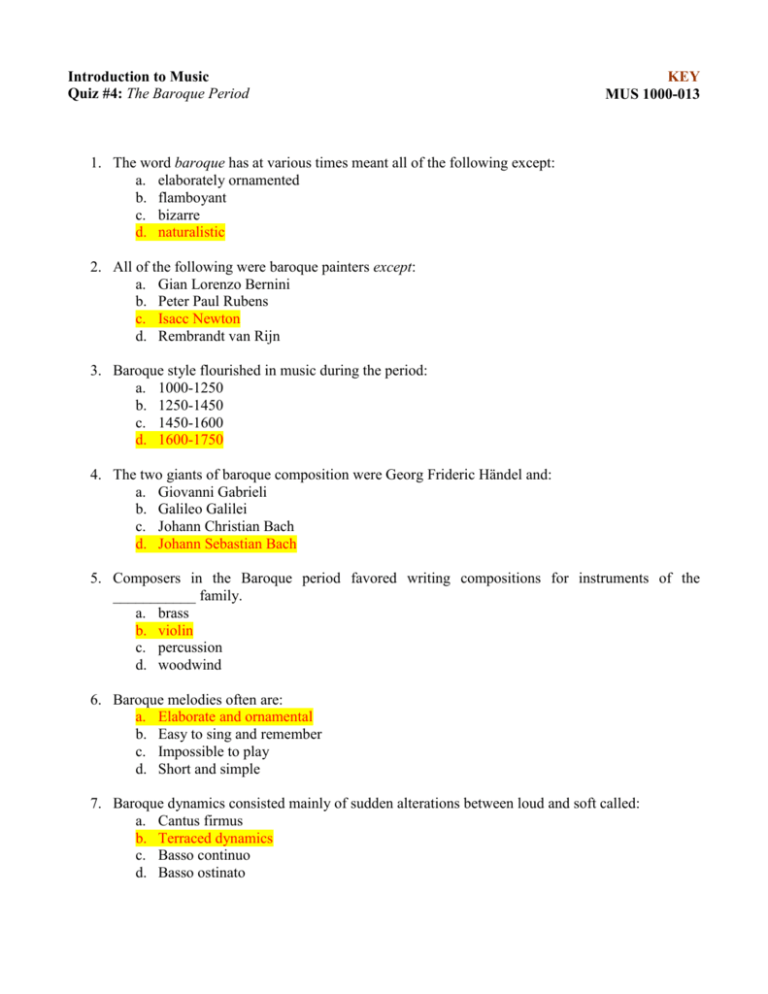
Introduction to Music Quiz #4: The Baroque Period KEY MUS 1000-013 1. The word baroque has at various times meant all of the following except: a. elaborately ornamented b. flamboyant c. bizarre d. naturalistic 2. All of the following were baroque painters except: a. Gian Lorenzo Bernini b. Peter Paul Rubens c. Isacc Newton d. Rembrandt van Rijn 3. Baroque style flourished in music during the period: a. 1000-1250 b. 1250-1450 c. 1450-1600 d. 1600-1750 4. The two giants of baroque composition were Georg Frideric Händel and: a. Giovanni Gabrieli b. Galileo Galilei c. Johann Christian Bach d. Johann Sebastian Bach 5. Composers in the Baroque period favored writing compositions for instruments of the ___________ family. a. brass b. violin c. percussion d. woodwind 6. Baroque melodies often are: a. Elaborate and ornamental b. Easy to sing and remember c. Impossible to play d. Short and simple 7. Baroque dynamics consisted mainly of sudden alterations between loud and soft called: a. Cantus firmus b. Terraced dynamics c. Basso continuo d. Basso ostinato 8. The word movement in music normally refers to: a. Music for the ballet b. A piece that sounds fairly complete and independent but is part of a larger composition c. The rising and falling of the melodic contour d. The rhythm of a piece 9. The position of the composer during the baroque period was that of: a. A free agent working on commissions b. An equal to the nobility, based on merit c. A high-class servant with few personal rights d. A low-class wandering minstrel 10. Presenting the subject of a fugue in lengthened time values is called: a. inversion b. augmentation c. retrograde d. diminution 11. A song for solo voice with orchestral accompaniment is called: a. aria b. duet c. ensemble d. solo 12. An ________ is an orchestral composition performed before the curtain rises on a dramatic work. a. overture b. aria c. opera d. opening 13. Castrati a. Received the highest fees of any musicians b. Combined the lung power of a man with the vocal range of the woman c. Were male singers who had been castrated before puberty d. All of the above 14. Embellishments are: a. Ornamental tones not printed in the music that 17th and 18th century performers were expected to add to the melody b. Music created at the same time it is performed c. Notes printed in the music that embellish the melody d. Obsolete in contemporary performances 15. Antonio Vivaldi spent most of his life working at an institution for orphaned and illegitimate girls in: a. Rome b. Venice c. Florence d. Cremona 16. Of Bach’s twenty children, ______ went on to become well-known composers. a. two b. three c. four d. five 17. Bach was recognized as the most eminent ________ of his day. a. organist b. composer c. violinist d. cellist 18. Sets of dance-inspired instrumental movements are called: a. sonatas b. concertos c. suites d. cantats 19. The various dances of the baroque suite are usually: a. Polyphonic in texture b. In theme and variation form c. In AABB form d. In ABA form 20. George Frideric Handel’s Messiah is an example of: a. an oratorio b. an opera c. musical theater d. a song Extra Credit: Name the composer of the selection currently being played in class: Pachelbel: Canon in D

